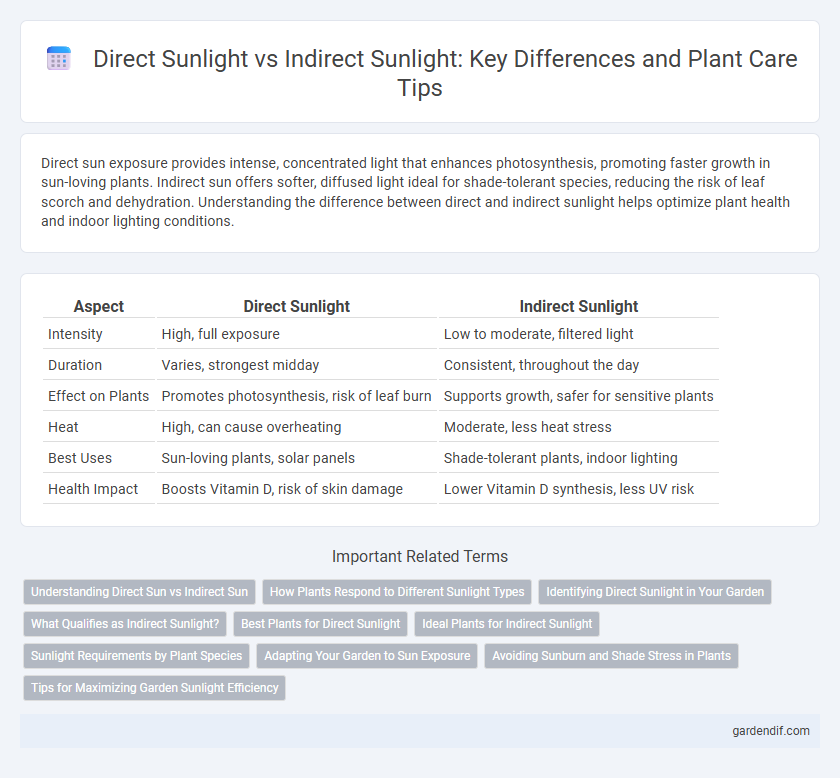
Direct Sun vs Indirect Sun Illustration
Direct sun exposure provides intense, concentrated light that enhances photosynthesis, promoting faster growth in sun-loving plants. Indirect sun offers softer, diffused light ideal for shade-tolerant species, reducing the risk of leaf scorch and dehydration. Understanding the difference between direct and indirect sunlight helps optimize plant health and indoor lighting conditions.
Table of Comparison
| Aspect | Direct Sunlight | Indirect Sunlight |
|---|---|---|
| Intensity | High, full exposure | Low to moderate, filtered light |
| Duration | Varies, strongest midday | Consistent, throughout the day |
| Effect on Plants | Promotes photosynthesis, risk of leaf burn | Supports growth, safer for sensitive plants |
| Heat | High, can cause overheating | Moderate, less heat stress |
| Best Uses | Sun-loving plants, solar panels | Shade-tolerant plants, indoor lighting |
| Health Impact | Boosts Vitamin D, risk of skin damage | Lower Vitamin D synthesis, less UV risk |
Understanding Direct Sun vs Indirect Sun
Direct sunlight delivers intense, focused solar rays that provide maximum energy and warmth, essential for sun-loving plants and solar panel efficiency. Indirect sunlight consists of diffused or reflected light, offering gentler illumination ideal for shade-tolerant plants and indoor environments. Understanding the distinction supports optimal plant growth, energy use, and spatial planning based on sunlight exposure.
How Plants Respond to Different Sunlight Types
Plants exposed to direct sunlight typically exhibit robust growth as they receive maximum photosynthetically active radiation (PAR) essential for chlorophyll production and energy synthesis. In contrast, plants in indirect sunlight adapt by developing larger leaves or enhanced chlorophyll concentrations to maximize light absorption under diffused or lower light conditions. This differential response influences plant morphology, flowering cycles, and overall health, making light quality a critical factor in horticulture and agriculture.
Identifying Direct Sunlight in Your Garden
Identifying direct sunlight in your garden involves observing the areas that receive unobstructed rays from the sun for several hours daily, typically marked by sharp, well-defined shadows. Direct sunlight zones often face south or southwest in the northern hemisphere, where sunlight intensity is highest between 10 a.m. and 4 p.m. Measuring sunlight duration with tools like a sunlight meter or tracking shadow movements throughout the day helps accurately pinpoint spots ideal for sun-loving plants.
What Qualifies as Indirect Sunlight?
Indirect sunlight refers to natural light that reaches a plant without direct exposure to the sun's rays, often filtered through obstacles like curtains, windows, or foliage. This type of light typically provides lower intensity and diffuse illumination, ideal for plants that require moderate light without the risk of leaf burn. Indirect sunlight is commonly found in shaded areas, near east- or north-facing windows, and under tree canopies where sunlight is softened and dispersed.
Best Plants for Direct Sunlight
Plants thriving in direct sunlight include succulents, cacti, and sunflowers, known for their high light tolerance and vibrant growth. These species possess adaptations like thick, waxy leaves or deep root systems to withstand intense solar radiation and reduced moisture. Optimal growth occurs with at least six hours of unfiltered, full-spectrum sunlight, making them ideal for sun-soaked windowsills or outdoor gardens.
Ideal Plants for Indirect Sunlight
Ideal plants for indirect sunlight include low-light tolerant species such as snake plants (Sansevieria), pothos (Epipremnum aureum), and peace lilies (Spathiphyllum). These plants thrive in shaded or filtered light conditions, making them perfect for indoor spaces away from direct sun exposure. Indirect sunlight helps prevent leaf scorch and maintains optimal growth by providing diffused light energy.
Sunlight Requirements by Plant Species
Plant species exhibit diverse sunlight requirements, with some thriving under direct sun exposure while others prefer indirect sunlight to prevent leaf scorch and dehydration. Succulents and many flowering plants demand 6-8 hours of direct sunlight daily for optimal growth and blooming, whereas ferns and shade-loving houseplants flourish in filtered light or partial shade with indirect sun. Accurate matching of species to sunlight conditions ensures healthy photosynthesis, robust development, and maximum chlorophyll production.
Adapting Your Garden to Sun Exposure
Adapting your garden to sun exposure requires understanding the differences between direct and indirect sunlight, as direct sun delivers full-spectrum light essential for photosynthesis, while indirect sun offers diffused light ideal for shade-loving plants. Selecting plants based on their sun tolerance--full sun, partial sun, or shade--ensures healthy growth and maximizes photosynthetic efficiency. Strategic placement of plants considering daily sun patterns, along with soil moisture management, optimizes their adaptation to varying light conditions.
Avoiding Sunburn and Shade Stress in Plants
Direct sunlight exposes plants to intense UV rays, increasing the risk of sunburn, which causes leaf scorch and cellular damage. Indirect sun provides filtered light that reduces heat stress and prevents dehydration while still supporting photosynthesis. Proper placement in partial shade helps avoid shade stress by balancing light needs without overexposure.
Tips for Maximizing Garden Sunlight Efficiency
Place sun-loving plants in areas with direct sun exposure for at least six hours daily to ensure optimal photosynthesis and growth. Use reflective surfaces like white walls or mulch to increase light intensity for plants in indirect sun locations. Rotate plants regularly to balance sunlight distribution and prevent uneven growth, maximizing garden sunlight efficiency.
Direct Sun vs Indirect Sun Infographic

 gardendif.com
gardendif.com